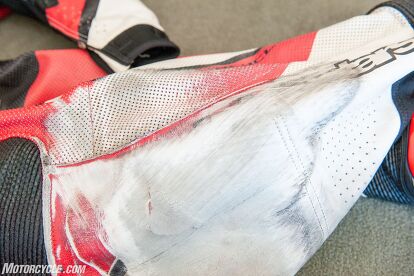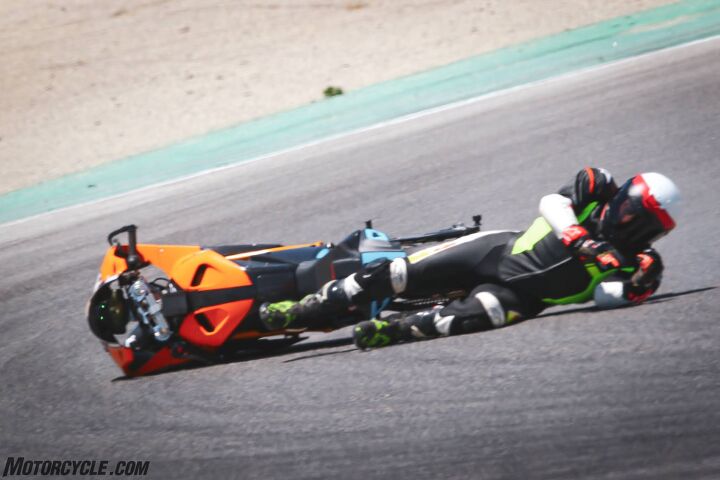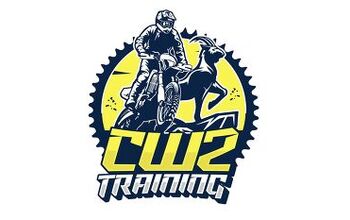What To Do With Crashed Leathers

Anthony's Leatherworks: A Legacy of Fixing Your Mistakes
As a kid, I remember my folks would take their shoes to the local shoe repair shop. I take it for granted now since I’ve been working from home long before it was cool, but there was a time when people not only had to go into an office, they also had to wear nice clothes, too! And the bit of that wardrobe that got the most punishment were the shoes. Those business shoes never looked comfortable, with their hard soles and weird patterns on the leather. But they lasted a long time, and if the soles ever wore out – which they did regularly with my folks – the local repair shop (I guess they were called cobblers even further back in time) could just put a new sole on and breathe new life into what would have been (re)tired shoes.
It’s this idea that old, and seemingly worn-out, goods don’t need to end up in the trash. “Repair, not replace,” is the popular adage these days, and it’s as true now as it has been since the early cobblers first set up their shops on cobblestone streets. Little did I know when I was a kid, but shoe repair shops would prove valuable to me and the greater motorcycling community as a whole.
Motorcycles fall down. Usually with people on them. In doing so, the gear the rider or passenger is wearing gets scuffed or even torn. Assuming the jacket or suit (and sometimes even boots) are made from leather, guess who can often fix it? That’s right, a shoe repair store. When you think about it, the tools of the shoe repair trade – big sewing machines, big needles, adhesives, and uh… more leather – are also useful for other leather goods, including motorcycle gear. The thing is, not many shoe repair stores have thought about it.
Anthony’s Leatherworks has. A small corner shop in the affluent Corona del Mar locale of Southern California, you’d expect Anthony’s to cater to repairing Prada bags and Balenciaga shoes, not Alpinestars leathers from some motorcycle journalist moonlighting as a wannabe racer. Well, when it comes to fixing leather goods, wherever they may be from, Anthony’s does it all.
Good, ‘Cuz I Need Them
The thing about streaks is that they eventually come to an end. Including mine. I had a long run going where I hadn’t fallen down on a motorcycle, not even at the racetrack. I knew the time would eventually come though, and it did in big fashion during an AHRMA race at Laguna Seca, when another rider exercised a complete lack of judgment and punted me off my bike at 100 mph, sending me sliding down the road for what seemed like an eternity. My leathers definitely looked second-hand, but somehow, the only damage was a busted zipper on my right arm, a hole that burned through the kevlar and stretch panel just above the leather on my right arm, and a couple tiny holes on the butt area. Other than a tiny bit of road rash on my right arm, I walked away fine.
Then came the incident earlier this year where I highsided myself in a race while trying to catch the leader and not only put my leathers through the wringer, but also inadvertently discovered how well a Forcite helmet protects my head (pretty well, I might add). It was another big blow, with my leathers wearing through on my back and hips. The speed hump also took a good beating, and somehow, the stretch panel above the speed hump, the one resting against the contours of my neck, also separated and exposed the internal Kevlar lining like a stuffed turkey.
Greg Sermabeikian, the owner of Anthony’s Leatherworks, didn’t even skip a beat when I brought the suits to him. The shop’s been around since 1948 when Greg’s dad, Anthony, thought a leather repair business made a lot of sense. Turns out dad was right. Greg’s since taken over the business, and while the company is still well known in the community for fixing shoes, purses, bomber jackets, and anything else with leather, for the past 20-odd years the brand has been getting separate recognition in motorcycle circles – circles much bigger than Corona del Mar – with its ability to bring seemingly ruined motorcycle leathers back to life.
Which is why Greg hardly batted an eye when I showed him my suits. He’s seen much worse. He speaks in a matter-of-fact fashion as if whatever’s wrong has an easy solution. “Oh yeah, we can just replace that whole panel,” he says, in regards to my mangled speed hump. Um, okay. Greg’s “nothing is too big, nor too small” attitude comes to be reassuring, as I start to ease up and trust that my leathers are in good hands, and yes, I will be able to wear them again. (Side note: if truly, something is beyond repair or just isn’t worth the cost to fix, I’ve seen him tell customers that, too).
While I didn’t need it this time, Anthony’s also offers alterations, as many customers will bring off-the-shelf (or even botched custom) suits in for that semi-custom fit. Their reputation has become so big, in fact, that Alpinestars, Dainese, Spidi, Mithos, and others, will send suits to them for warranty work. But perhaps the biggest achievement so far is Anthony’s becoming a MotoAmerica sponsor. Has been since 2020. Riders with wrecked suits can hand them off to Greg, or one of his reps at the track, and the suit will be sent back to Corona del Mar Monday after the races (unfortunately they can’t do on-site repairs). Roughly two weeks later (or faster if rush service is needed), the finished suit is shipped back to wherever you are in the country. Talk about targeting your business.
In my case, all I wanted was for my suits to be functional again. They didn’t need to look new again. Patch whatever holes there are, replace zippers, and fix the stretch panels. If I wanted to go the extra mile, Anthony’s could have not only made the repairs, but color-matched patches to match the existing leather. Since my red suit had screen-printed designs, that service wasn’t possible. But if there’s road rash over a solid color, Greg and his team could make it disappear by personally mixing and matching paint, like a hardware store, until the color matches your suit. Re-applying sponsor logos or personal patches is also a service they can do, but one I chose to skip.
Where the Magic Happens
Back at the Corona del Mar base, the suits undergo surgery. Really, for anyone with a basic understanding of sewing, this really isn’t rocket science. Starting with the black suit, expert use of an X-Acto knife carved away the frayed section of the neck stretch panel and a new piece was cut to size and sewn in place. Despite looking pretty bad, the speed hump on the back suffered superficial damage. The leather had torn, exposing the foam core material that makes up the hump. But as far as the Anthony’s team were concerned, it was a strip of leather needing to be removed and replaced. Matching the exact orange color of leather as the original would have been more hassle than it was worth, so we went with black instead. The shape and contour of the hump can be a bit tricky to lay a new piece of leather over, but some indirect heat allows the leather to stretch a little, while adhesive is laid down for the leather to grab onto. Orange thread to match the existing leather then ensures the new leather isn’t going anywhere unless I fall off again (knocks wood).
The other significant repairs are patching a hole to the left of the speed hump that wore all the way through and a hole on the left hip that did the same. In both instances, the fix was as simple as removing any loose pieces of leather and simply adding a leather patch over the hole. If anything, the tricky bit was adding the hip patch, as the leather butted up against a seam where two large panels of leather (one for the front of the leg, the other for the back) come together. The new piece is sewn in place and matches the seam perfectly, possibly even strengthening the connection of the two panels in that one spot.
For the red suit, the most damage is in the right arm. As I was sliding on the ground, my right arm somehow rolled in such a way that the leather wasn’t sliding on the pavement – the stretch panels were. Obviously, with far less abrasion resistance, those panels tore away quickly (and left a small burn mark on my arm). Even the zipper closure split in two. Not to worry; new Kevlar panels were sewn in place along with a new section of stretch material to match the original. The original YKK zipper was removed and an identical replacement was put in its place.
Moving towards the back and seat sections of the suit there were small holes, maybe about the size of a US nickel, just above the accordion panel. Unlike on the black suit, where large patches were simply sewn over the top of a hole, for little repairs like this the new patch of leather is sewn inside of the suit, so the repair is made from the inside out. Then again, it might have also been done this way because accessing the area directly above the accordion panel is much easier from inside the suit. Either way, the holes are fixed, the stretch panels and Kevlar are repaired, and now both suits are ready to go back into service.
What’s the Damage?
Without any real barometer as to what a repair like this would cost, I really had no idea what to expect. Yes, Anthony’s has a price list, but those are ballpark estimates and the scope of individual repairs can vary wildly in situations like these. Granted, since I only asked for the suits to be functional, not pretty, that brought the price down.
In the end, the total came out to $470 for both suits – $240 for the red suit, $230 for the black. Totally reasonable, I’d say. Now, in the interest of full disclosure, I should state that I didn’t pay $470 to have these repairs done, despite the fact I had my credit card in my hand, ready to give to Greg. So, yes, I would have gladly forked over the dough had he asked, though I’ll tell myself it’s a layaway plan for future me in case I fall down again.
If you have a damaged leather suit, jacket, or even boots you’ve been thinking about tossing, it might be worth your while to breathe some new life into them. There are various specialty shops around the country that have built up a local reputation for fixing more than just shoes, but if you’re at all near the SoCal area, Anthony’s Leatherworks has the expertise to do it right. Plus, it feels nice to support those who support the sport.
*There are far more photos of the store, the damaged suits, and the repairs than we have space for above. So check them all out in the photo gallery below.*
We are committed to finding, researching, and recommending the best products. We earn commissions from purchases you make using the retail links in our product reviews. Learn more about how this works.
Become a Motorcycle.com insider. Get the latest motorcycle news first by subscribing to our newsletter here.

Troy's been riding motorcycles and writing about them since 2006, getting his start at Rider Magazine. From there, he moved to Sport Rider Magazine before finally landing at Motorcycle.com in 2011. A lifelong gearhead who didn't fully immerse himself in motorcycles until his teenage years, Troy's interests have always been in technology, performance, and going fast. Naturally, racing was the perfect avenue to combine all three. Troy has been racing nearly as long as he's been riding and has competed at the AMA national level. He's also won multiple club races throughout the country, culminating in a Utah Sport Bike Association championship in 2011. He has been invited as a guest instructor for the Yamaha Champions Riding School, and when he's not out riding, he's either wrenching on bikes or watching MotoGP.
More by Troy Siahaan


















































































































































































Comments
Join the conversation
You would know!
Just kidding buddy. I haven’t used my Evans material in a long time.
The gravel goblin is seen in that second photo!